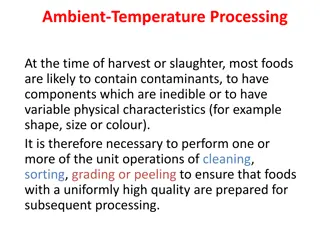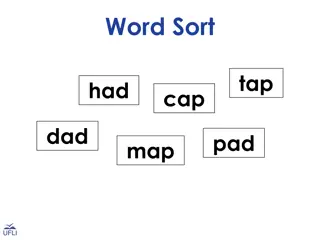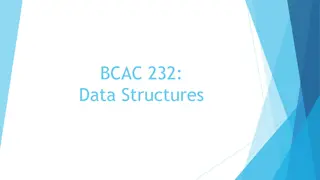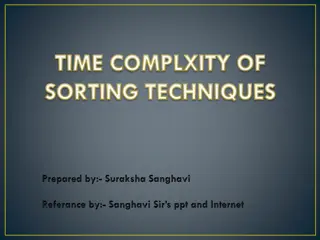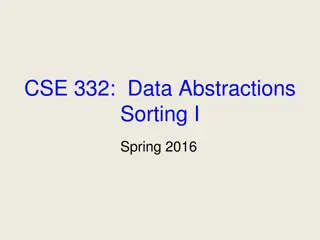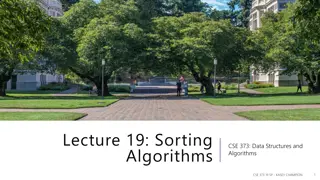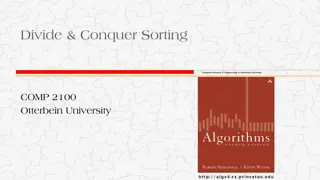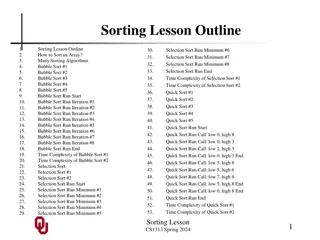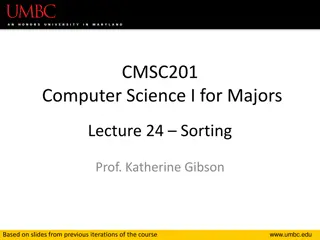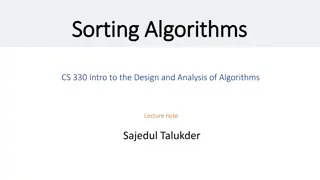
Sorting Algorithms Overview and Complexity Analysis
Explore various sorting algorithms including Bubble Sort, Insertion Sort, Merge Sort, Quick Sort, Heap Sort, Radix Sort, and Bucket Sort. Understand their working principles, complexities, and optimization techniques. Watch informative videos and engage in in-lab exercises for hands-on learning.
Download Presentation

Please find below an Image/Link to download the presentation.
The content on the website is provided AS IS for your information and personal use only. It may not be sold, licensed, or shared on other websites without obtaining consent from the author. If you encounter any issues during the download, it is possible that the publisher has removed the file from their server.
You are allowed to download the files provided on this website for personal or commercial use, subject to the condition that they are used lawfully. All files are the property of their respective owners.
The content on the website is provided AS IS for your information and personal use only. It may not be sold, licensed, or shared on other websites without obtaining consent from the author.
E N D
Presentation Transcript
CSCE-221 Sorting Prof. Lupoli Zhipei Yan 10/3/2019 From Dr. Scott Schafer and notes of Prof. Lupoli http://faculty.cs.tamu.edu/schaefer/teaching/221_Fall2018/Lectures/Sorting.ppt
Outline Bubble Sort Insertion Sort Merge Sort Quick Sort Heap sort, Radix Sort, Bucket Sort All Sort Examples assume ascending order 2 3 5 2 15 29 42
Video & Short inLab exercise https://youtu.be/3CeuJQyFI7A PLEASE ASK ANY QUESTIONS DURING THE VIDEO!!
Complexity of Bubble Sort Two loops each proportional to n T(n) = O(n2) AlgorithmbubbleSort(S, C) Input sequence S, comparator C Output sequence S sorted according to C for ( i = 0; i < S.size(); i++ ) for ( j = 1; j < S.size() i; j++ ) if ( S.atIndex ( j 1 ) > S.atIndex ( j ) ) S.swap ( j-1, j ); return(S) It is possible to speed up bubble sort using the last index swapped, but doesn t affect worst case complexity
Insertion Sort Algorithm starts from the smallest, to the largest. Left most end of the array is sorted Looks at the next element (key), and places it in the correct ordered spot. Need to move elements to make space for key remember as a deck of cards , each one you draw you immediately put in order again n-1 passes to complete
Video & Short inLab exercise https://youtu.be/y0_LvwFAuT8
Insertion Sort Source : http://www.cs.sfu.ca/CourseCentral/225/jmanuch/lec/6-2.ppt
1 2 12 16 13 15 35
Complexity of Insertion Sort Two nested loops - dependent Top loop runs n time Bottom loop move elements to the right if they are > than key AlgorithmInsertion(S, C) Input sequence S, comparator C Output sequence S sorted according to C for ( i = 1; i < S.size(); i++ ) { key = S[i]; for ( j = i - 1; j > 0 && S[j] > key; j-- ) { S[j + 1] = S[j]; } S[j + 1] = key; } return S; Time Complexity T(n) = O(n2)
Merge Sort 7 2 9 4 2 4 7 9 7 2 2 7 9 4 4 9 7 7 2 2 9 9 4 4
Merge Sort Merge sort is based on the divide-and-conquer paradigm. It consists of three steps: Divide: partition input sequence S into two sequences S1and S2 of about n 2 elements each Recur: recursively sort S1 and S2 Conquer: merge S1and S2 into a unique sorted sequence AlgorithmmergeSort(S, C) Input sequence S, comparator C Output sequence S sorted according to C if S.size() > 1 { (S1, S2) := partition(S, S.size()/2) S1 := mergeSort(S1, C) S2 := mergeSort(S2, C) S := merge(S1, S2) } return(S)
D&C algorithm analysis with recurrence equations Divide-and conquer is a general algorithm design paradigm: Divide: divide the input data S into k (disjoint) subsets S1,S2, , Sk Recur: solve the sub-problems associated with S1, S2, , Sk Conquer: combine the solutions for S1, S2, , Sk into a solution for S The base case for the recursion are sub-problems of constant size Analysis can be done using recurrence equations (relations) When the size of all sub-problems is the same (frequently the case) the recurrence equation representing the algorithm is: T(n) = D(n) + k T(n/c) + C(n) Where D(n) is the cost of dividing S into the k subproblems, S1, S2, S3, ., Sk There are k subproblems, each of size n/c that will be solved recursively C(n) is the cost of combining the subproblem solutions to get the solution for S
Now, back to mergesort The running time of Merge Sort can be expressed by the recurrence equation: AlgorithmmergeSort(S, C) Input sequence S, comparator C Output sequence S sorted according to C if S.size() > 1 { (S1, S2) := partition(S, S.size()/2) S1 := mergeSort(S1, C) S2 := mergeSort(S2, C) S := merge(S1, S2) } return(S) T(n) = 2T(n/2) + M(n) We need to determine M(n), the time to merge two sorted sequences each of size n/2.
Merging Two Sorted Sequences Algorithmmerge(A, B) Input sequences A and B with n/2 elements each Output sorted sequence of A B The conquer step of merge- sort consists of merging two sorted sequences A and B into a sorted sequence S containing the union of the elements of A and B Merging two sorted sequences, each with n 2 elements and implemented by means of a doubly linked list, takes O(n) time M(n) = O(n) S empty sequence while A.isEmpty() B.isEmpty() if A.first() < B.first() S.insertLast(A.removeFirst()) else S.insertLast(B.removeFirst()) while A.isEmpty() S.insertLast(A.removeFirst()) while B.isEmpty() S.insertLast(B.removeFirst()) return S
And the complexity of mergesort So, the running time of Merge Sort can be expressed by the recurrence equation: AlgorithmmergeSort(S, C) Input sequence S, comparator C Output sequence S sorted according to C if S.size() > 1 { (S1, S2) := partition(S, S.size()/2) S1 := mergeSort(S1, C) S2 := mergeSort(S2, C) S := merge(S1, S2) } return(S) T(n) = 2T(n/2) + M(n) = 2T(n/2) + O(n) = O(nlogn)
Merge Sort Execution Tree (recursive calls) An execution of merge-sort is depicted by a binary tree each node represents a recursive call of merge-sort and stores unsorted sequence before the execution and its partition sorted sequence at the end of the execution the root is the initial call the leaves are calls on subsequences of size 0 or 1 7 2 9 4 2 4 7 9 7 2 2 7 9 4 4 9 7 7 2 2 9 9 4 4
Execution Example Partition 7 2 9 4 3 8 6 1 1 2 3 4 6 7 8 9 7 2 9 4 2 4 7 9 3 8 6 1 1 3 6 8 7 2 2 7 9 4 4 9 3 8 3 8 6 1 1 6 7 7 2 2 9 9 4 4 3 3 8 8 6 6 1 1
Execution Example (cont.) Recursive call, partition 7 2 9 4 3 8 6 1 1 2 3 4 6 7 8 9 7 2 9 4 2 4 7 9 3 8 6 1 1 3 6 8 7 2 2 7 9 4 4 9 3 8 3 8 6 1 1 6 7 7 2 2 9 9 4 4 3 3 8 8 6 6 1 1
Execution Example (cont.) Recursive call, partition 7 2 9 4 3 8 6 1 1 2 3 4 6 7 8 9 7 2 9 4 2 4 7 9 3 8 6 1 1 3 6 8 7 2 2 7 9 4 4 9 3 8 3 8 6 1 1 6 7 7 2 2 9 9 4 4 3 3 8 8 6 6 1 1
Execution Example (cont.) Recursive call, base case 7 2 9 4 3 8 6 1 1 2 3 4 6 7 8 9 7 2 9 4 2 4 7 9 3 8 6 1 1 3 6 8 7 2 2 7 9 4 4 9 3 8 3 8 6 1 1 6 7 7 2 2 9 9 4 4 3 3 8 8 6 6 1 1
Execution Example (cont.) Recursive call, base case 7 2 9 4 3 8 6 1 1 2 3 4 6 7 8 9 7 2 9 4 2 4 7 9 3 8 6 1 1 3 6 8 7 2 2 7 9 4 4 9 3 8 3 8 6 1 1 6 7 7 2 2 9 9 4 4 3 3 8 8 6 6 1 1
Execution Example (cont.) Merge 7 2 9 4 3 8 6 1 1 2 3 4 6 7 8 9 7 2 9 4 2 4 7 9 3 8 6 1 1 3 6 8 7 2 2 7 9 4 4 9 3 8 3 8 6 1 1 6 7 7 2 2 9 9 4 4 3 3 8 8 6 6 1 1
Execution Example (cont.) Recursive call, , base case, merge 7 2 9 4 3 8 6 1 1 2 3 4 6 7 8 9 7 2 9 4 2 4 7 9 3 8 6 1 1 3 6 8 7 2 2 7 9 4 4 9 3 8 3 8 6 1 1 6 7 7 2 2 9 9 4 4 3 3 8 8 6 6 1 1
Execution Example (cont.) Merge 7 2 9 4 3 8 6 1 1 2 3 4 6 7 8 9 7 2 9 4 2 4 7 9 3 8 6 1 1 3 6 8 7 2 2 7 9 4 4 9 3 8 3 8 6 1 1 6 7 7 2 2 9 9 4 4 3 3 8 8 6 6 1 1
Execution Example (cont.) Recursive call, , merge, merge 7 2 9 4 3 8 6 1 1 2 3 4 6 7 8 9 7 2 9 4 2 4 7 9 3 8 6 1 1 3 6 8 7 2 2 7 9 4 4 9 3 8 3 8 6 1 1 6 7 7 2 2 9 9 4 4 3 3 8 8 6 6 1 1
Execution Example (cont.) Merge 7 2 9 4 3 8 6 1 1 2 3 4 6 7 8 9 7 2 9 4 2 4 7 9 3 8 6 1 1 3 6 8 7 2 2 7 9 4 4 9 3 8 3 8 6 1 1 6 7 7 2 2 9 9 4 4 3 3 8 8 6 6 1 1
Analysis of Merge-Sort The height h of the merge-sort tree is O(log n) at each recursive call we divide in half the sequence, The work done at each levelis O(n) At level i, we partition and merge 2i sequences of size n 2i Thus, the total running time of merge-sort is O(n log n) depth #seqs size Cost for level n n 0 1 n 2 n 1 2 n 2i i n 2i logn n 2logn = n n/2logn = 1
Summary of Sorting Algorithms (so far) Algorithm Time Notes Selection Sort O(n2) Slow, in-place For small data sets Slow, in-place For small data sets Slow, in-place For small data sets Fast, in-place For large data sets Insertion Sort O(n2) WC, AC O(n) BC O(n2) WC, AC O(n) BC O(nlog n) Bubble Sort Heap Sort Merge Sort O(nlogn) Fast, sequential data access For huge data sets
Quick-Sort 7 4 9 6 2 2 4 6 7 9 4 2 2 4 7 9 7 9 2 2 9 9
Quick Sort https://upload.wikimedia.org/wikipedia/commons/6/6a/Sorting_quicksort_anim.gif
Quick-Sort Quick-sort is a randomized sorting algorithm based on the divide-and-conquer paradigm: Divide: pick a random element x (called pivot) and partition S into L elements less than x E elements equal x G elements greater than x Recur: sort L and G Conquer: join L, Eand G x x L E G x
Analysis of Quick Sort using Recurrence Relations Assumption: random pivot expected to give equal sized sublists The running time of Quick Sort can be expressed as: AlgorithmQuickSort(S,l,r) Input sequence S, ranks l and r Output sequence S with the elements of rank between l and r rearranged in increasing order ifl r return i a random integer between l and r x S.elemAtRank(i) (h,k) Partition(x) QuickSort(S,l,h 1) QuickSort(S,k + 1,r) T(n) = 2T(n/2) + P(n) T(n) - time to run quicksort() on an input of size n P(n) - time to run partition() on input of size n
Partition Algorithmpartition(S,p) Input sequence S, position p of pivot Output subsequences L,E, G of the elements of S less than, equal to, or greater than the pivot, resp. L,E, G empty sequences x S.remove(p) while S.isEmpty() y S.remove(S.first()) ify < x L.insertLast(y) else if y = x E.insertLast(y) else { y > x } G.insertLast(y) return L,E, G We partition an input sequence as follows: We remove, in turn, each element y from S and We insert y into L, Eor G, depending on the result of the comparison with the pivot x Each insertion and removal is at the beginning or at the end of a sequence, and hence takes O(1) time Thus, the partition step of quick-sort takes O(n) time
So, the expected complexity of Quick Sort Assumption: random pivot expected to give equal sized sublists The running time of Quick Sort can be expressed as: AlgorithmQuickSort(S,l,r) Input sequence S, ranks l and r Output sequence S with the elements of rank between l and r rearranged in increasing order ifl r return i a random integer between l and r x S.elemAtRank(i) (h,k) Partition(x) QuickSort(S,l,h 1) QuickSort(S,k + 1,r) T(n) = 2T(n/2) + P(n) = 2T(n/2) + O(n) = O(nlogn)
Quick-Sort Tree An execution of quick-sort is depicted by a binary tree Each node represents a recursive call of quick-sort and stores Unsorted sequence before the execution and its pivot Sorted sequence at the end of the execution The root is the initial call The leaves are calls on subsequences of size 0 or 1 7 4 9 6 2 2 4 6 7 9 4 2 2 4 7 9 7 9 2 2 9 9
Worst-case Running Time The worst case for quick-sort occurs when the pivot is the unique minimum or maximum element One of L and G has size n 1 and the other has size 0 The running time is proportional to n + (n - 1) + + 2 + 1 = O(n2) Alternatively, using recurrence equations, T(n) = T(n-1) + O(n) = O(n2) depth time n 0 n 1 1 n 1 1
In-Place Quick-Sort Quick-sort can be implemented to run in-place In the partition step, we use swap operations to rearrange the elements of the input sequence such that the elements less than the pivot have rank less than l the elements greater than or equal to the pivot have rank greater than l The recursive calls consider elements with rank less than l elements with rank greater than l AlgorithminPlaceQuickSort(S,a,b) Input sequence S, ranks a and b ifa b return p S[b] l a r b-1 while (l r) while(l r & S[l] p) l++ while(r l & p S[r]) r-- if (l<r) swap(S[l], S[r]) swap(S[l], S[b]) inPlaceQuickSort(S,a,l-1) inPlaceQuickSort(S,l+1,b)
In-Place Partitioning Perform the partition using two indices to split S into L and E&G (a similar method can split E&G into E and G). l r (pivot = 6) 3 2 5 1 0 7 3 5 9 2 7 9 8 9 7 9 6 Repeat until l and r cross: Scan l to the right until finding an element > x. Scan r to the left until finding an element < x. Swap elements at indices l and r l r 3 2 5 1 0 7 3 5 9 2 7 9 8 9 7 9 6
Summary of Sorting Algorithms (so far) Algorithm Time Notes Selection Sort O(n2) Slow, in-place For small data sets Slow, in-place For small data sets Fast, in-place For large data sets Insertion/Bubble Sort Heap Sort O(n2) WC, AC O(n) BC O(nlog n) Quick Sort Exp. O(nlogn) AC, BC O(n2) WC Fastest, randomized, in-place For large data sets Merge Sort O(nlogn) Fast, sequential data access For huge data sets
Handout Exercise Complete Survey in Ecampus Questions?
References http://faculty.cs.tamu.edu/schaefer/teachin g/221_Fall2018/Lectures/Sorting.ppt https://en.wikipedia.org/wiki/Insertion_sort
Bubble Sort 5 7 2 6 9 3
Bubble Sort 5 7 2 6 9 3
Bubble Sort 5 7 2 6 9 3
Bubble Sort 5 2 7 6 9 3
Bubble Sort 5 2 7 6 9 3
Bubble Sort 5 2 6 7 9 3
Bubble Sort 5 2 6 7 9 3
Bubble Sort 5 2 6 7 9 3


